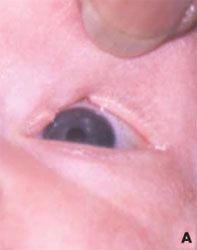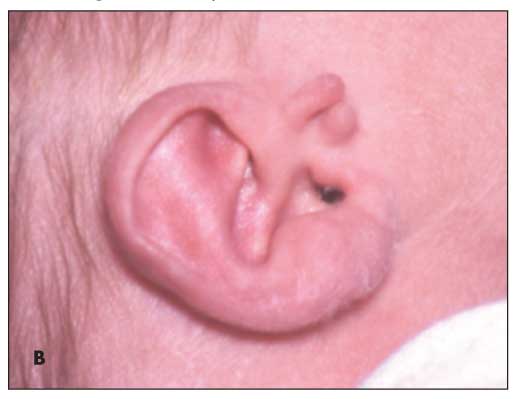Oculo-Auriculo-Vertebral Spectrum
This baby boy was born with bilateral medial colobomas of the upper eyelids without tarsal plates and bilateral accessory tragi. Radiographs showed no vertebral anomalies, and no other physical abnormalities were evident.

This baby boy was born with bilateral medial colobomas of the upper eyelids without tarsal plates (A) and bilateral accessory tragi (B). Radiographs showed no vertebral anomalies, and no other physical abnormalities were evident. The findings are part of an oculo-auriculo-vertebral spectrum, first described by Canton1 in 1861 and von Arlt2 in 1881. Synonyms include hemifacial microsomia, craniofacial microsomia, Goldenhar syndrome, Goldenhar-Gorlin syndrome, first and second branchial arch syndrome, first arch syndrome, facio-auriculo-vertebral syndrome, and lateral facial dysplasia. The disorder occurs in about 1 in 56,000 births, with a male to female ratio of 3:2.3 The exact incidence is unknown because of the variable expression of the syndrome.
Unilateral craniofacial anomalies are the usual presenting sign. Facial asymmetry may not be initially evident but may develop with age. On the involved side, the ear may be deformed and microtic, and the infant may be deaf; there may be unilateral facial paralysis and/or large mouth. Possible ocular anomalies include blindness, epibulbar lipodermoids, and colobomas of the upper lids. Accessory tragi may be bilateral. Vertebral anomalies may be present, and scoliosis may develop.

As the patient ages, heart and lung problems may occur. About 90% of affected patients are unable to live a normal life and have varying degrees of disability that require some type of assistive device (eg, hearing aid, glasses, cane, walker, or wheelchair) or assisted living.4 Life expectancy depends on the syndrome’s severity.
The cause of the syndrome is unknown; however, the constellations of anomalies suggest some disturbance in development of the branchial arches at about 30 to 45 days’ gestation. Although most cases are isolated, familial patterns have been reported. Some aspects of the spectrum have been seen in a variety of chromosomal aneuploidies. Only rarely has there been concordance in monozygotic twins.
No diagnostic test for this syndrome exists. Chromosome analysis is prudent given the number of associated chromosomal anomalies.
Syndromes with overlapping features that should be considered in the differential diagnosis of oculo-auriculo-vertebral spectrum include Townes-Brocks syndrome, branchio-oto-renal syndrome, Treacher Collins syndrome, maxillofacial dysostosis, Nager acrofacial dysostosis, postaxial acrofacial dysostosis, and the VATER, CHARGE, and MURICS associations.
Because of the complexity of this spectrum and the possibility of virtually any body system being (or becoming) involved, treatment is best rendered at a tertiary care pediatric center. Many family resources are available.4
References:
REFERENCES:
1.
Canton E. Arrest of development of the left perpendicular ramus of the lower jaw combined with malformation of the external ear.
Trans Pathol Soc Lond.
1861;12:237-238.
2.
von Arlt F.
Klinische Darstellung der Krankheiten des Teyes.
Wien: W Braunmüller; 1881.
3.
Gorlin RJ. Oculo-auriculo-vertebral spectrum. In: Cassidy SB, Allanson JE, eds.
Management of Genetic Syndromes.
2nd ed. Wilmington, DE: Wiley-Liss, Inc; 2005:399-405.
4.
The National Craniofacial Association. Goldenhar Syndrome.
http://www. faces-cranio.org
. Accessed January 20, 2010.